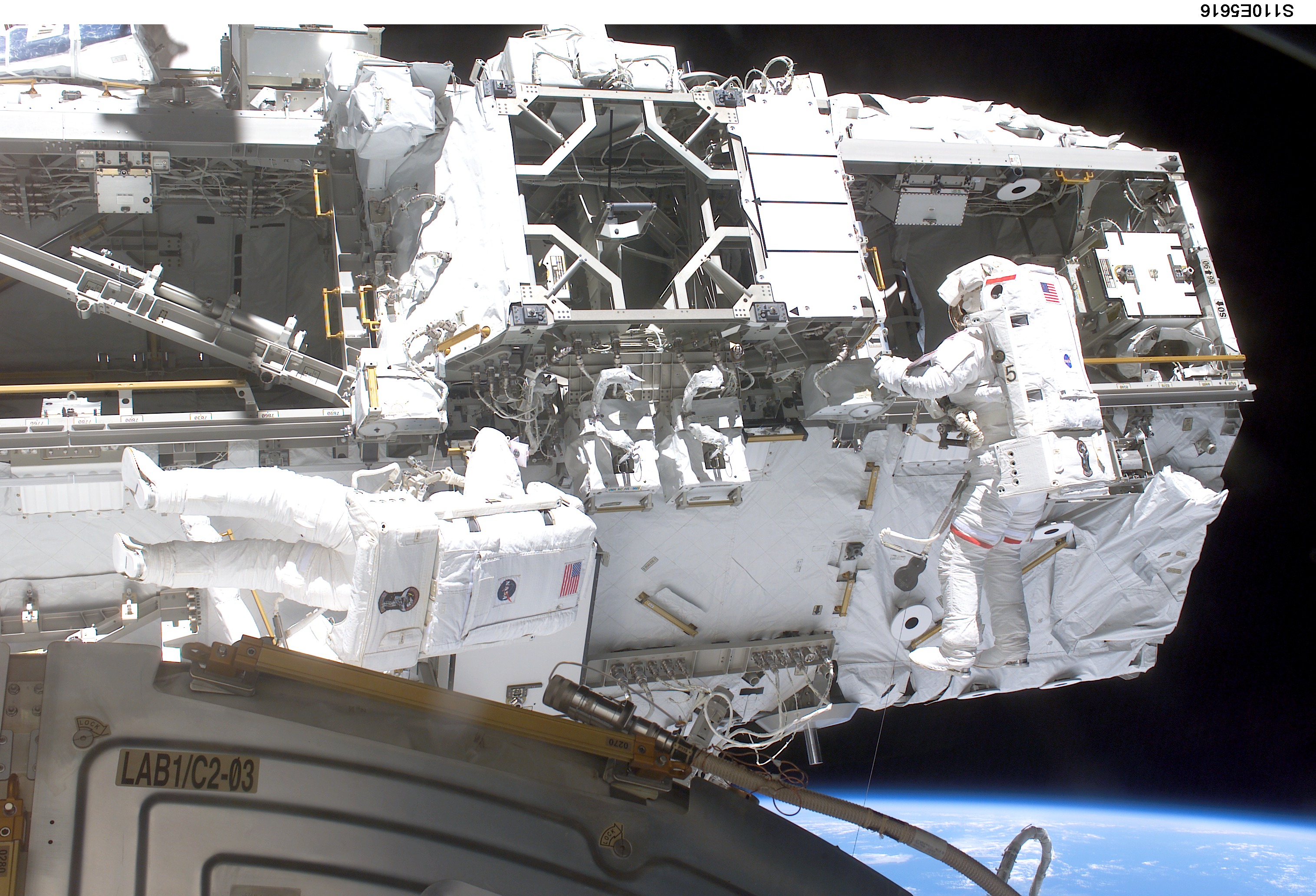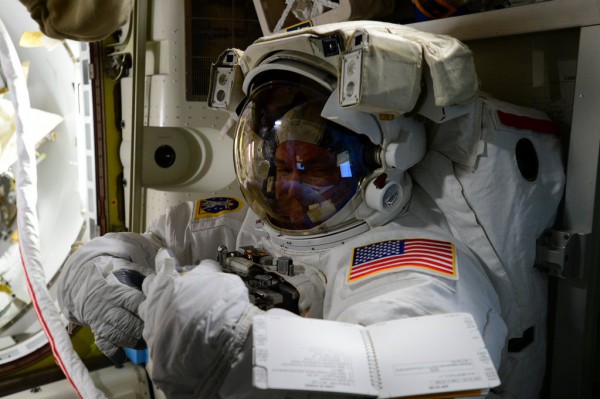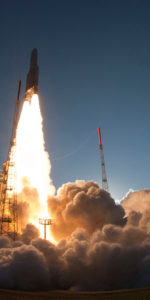
Only days after his successful launch into orbit and safe docking at the International Space Station (ISS), newly-arrived Expedition 46 resident Tim Kopra of NASA is expected to join Commander Scott Kelly on Monday, 21 December, for an “Unplanned EVA” lasting somewhere between three and 3.5 hours to secure the stalled Mobile Transporter (MT). The transporter was in the process of being moved between two worksites on the expansive Integrated Truss Structure (ITS), when it stalled late on Wednesday, and needs to be secured in readiness for station maneuvers in support of the launch and arrival of Russia’s Progress-MS cargo ship early next week.
As noted in a previous AmericaSpace article, the increment of Kopra, his Russian crewmate Yuri Malenchenko and Britain’s first “official” astronaut, Tim Peake, was expected to involve multiple EVAs, but not quite so soon after their arrival at the station.
In fact, with the exception of visiting shuttle construction flights, Monday’s EVA will mark one of the soonest into a mission that a long-duration ISS crew member has ever performed a spacewalk. During STS-102 in March 2001, incoming Expedition 2 astronauts Jim Voss and Susan Helms ventured outside the nascent ISS for a record-breaking eight hours and 56 minutes, just three days after leaving Earth. Several years later, in December 2006, Expedition 14 resident Suni Williams participated in an EVA, a week into her six-month increment, and was followed by newly-arrived Expedition 16’s Dan Tani during the STS-120 mission in October 2007.
More recently, Tim Kopra himself undertook an EVA with STS-127 astronaut Dave Wolf on 18 July 2009, just three days after launch, on the cusp of his two-month Expedition 20 increment. So too did fellow astronaut Nicole Stott, in the days after she flew to the station aboard STS-128, later that same summer.
Kelly, who will be making his third spacewalk, will be extravehicular crew member 1 (EV 1) wearing the U.S. spacesuit bearing the red stripes. Kopra, who arrived on the station on Dec. 15, will be making the second spacewalk of his career as extravehicular crew member 2 (EV 2) wearing the suit with no stripes. It will be the 191st spacewalk in support of station assembly and maintenance and the seventh spacewalk of the year by station crew members.
Kelly and Kopra will float out of the Quest airlock to the area where the Mobile Transporter has stalled to check out the position of its brake handles and other mechanisms to make sure the rail car can be commanded to move back to worksite 4 by robotic flight controllers at Mission Control, Houston. It is suspected that a brake handle on an equipment cart attached to the starboard side of the transporter may have inadvertently engaged, which if correct, should easily be released to allow for the transporter to be moved into place for its latching.
Kopra, launched last Tuesday aboard Soyuz TMA-19M with Malenchenko and Peake, has accrued five hours and 32 minutes from his STS-127 spacewalk and would thus have been in prime position to undertake an already planned series of U.S. EVAs in the opening months of 2016.
As detailed last week by AmericaSpace, U.S. EVA-34 is tentatively planned for 15-19 January and will involve the removal and replacement of the failed Sequential Shunt Unit (SSU), belonging to Power Channel 1B on the S-6 truss segment. Depending upon SpaceX’s Dragon launch manifest, this would be followed by two more U.S. EVAs in April to install and activate NASA’s International Docking Adapter (IDA)-2 at the forward port of the station’s Harmony node and perform other as-yet-unconfirmed tasks.

Yet as the week drew towards its end, efforts to stage what has been described as an “Unplanned EVA” gathered pace, following the unexpected stoppage of the Mobile Transporter (MT) at the midpoint of the station’s 356-foot-long (108.5-meter) Integrated Truss Structure (ITS). The truss, which supports four pairs of U.S.-built Solar Array Wings (SAWs) at its port and starboard extremities, also provides a home for the space station’s electrical and thermal control systems, as well as Orbital Replacement Unit (ORU) storage locations and scientific payloads, including the Alpha Magnetic Spectrometer (AMS).
Movement of the Canadian-built Canadarm2 robotic arm and its Mobile Base System (MBS) is conducted by means of the 1,950-pound (885 kg) transporter, which runs along the truss. Described as “the first railroad in space” at the time of its launch in April 2002, the MT—which measures about 9 feet (2.7 meters) wide and long, by about 38 inches (97 cm) in height—was installed onto the space station during shuttle Atlantis’ STS-110 mission and travels on rails to enable Canadarm2 to reach various worksites along the length of the expansive truss. “As it moves down the track, the train’s top speed is about 1 inch (2.5 cm) per second,” NASA noted prior to the MT’s launch. “It is usually operated by flight controllers…but the station crew could also operate it if needed. The MT isn’t a passenger train, since it only hauls equipment. The astronauts move along the railway during spacewalks by using special hand carts, called the Crew and Equipment Translation Aids (CETA).”
Late Wednesday, the MT was being moved by robotic flight controllers in the Mission Control Center (MCC) at the Johnson Space Center (JSC) in Houston, Texas, to a new worksite near the center of the truss for payload operations, when it suddenly stopped moving. “The cause of the stall is being evaluated,” NASA explained Friday, “but experts believe it may be related to a stuck brake handle.” The MT was in the process of traversing towards “Worksite 2”—located midway along the starboard side of the ITS—to support ongoing Robotic Refueling Mission (RRM) payload operations, when it stalled close to Worksite 4, near the U.S. Destiny laboratory.
Since the station was expected to see the departure of Russia’s Progress M-28M cargo ship (also known as “Progress 60P”) on Friday and the arrival of the new Progress-MS (or “Progress 62P”) on Wednesday, 23 December, it was a Program requirement for the MT to be properly latched into place and efforts got underway to move the transporter back to Worksite 4. “We tried several attempts to put it back to the same worksite that we just left,” explained Mr. Todd in Friday’s briefing. “We found ourselves about 6-8 inches (15-20 cm) short.” The team managed to move the MT to within 4 inches (10 cm) of the worksite, Mr. Todd continued, “but unfortunately that’s not enough to do the necessary latching that we need to support any dynamic events like maneuvering of the station and docking or undocking of vehicles.”
Having stalled so close to the midpoint of the truss, and within relatively easy reach of the station’s Quest airlock, was fortuitous on two fronts. Firstly, said Mr. Todd, “from a center-of-gravity standpoint, it’s actually in a very good position, relative to the loads that it might experience” and stressed that a stall further outboard along the port or starboard sides of the ITS could have proven more problematic. “We kinda got lucky,” he said. “If we’re going to have this kind of problem, we’re right in the middle of the truss.” For the spacewalkers, it will be possible for them to reach Worksite 4 “in relatively short order”. On the ground, the team reviewed loads analyses and were able to become more comfortable with the predicted perturbations across the ISS during efforts to maneuver the station into the proper attitude for the forthcoming Progress undocking and arrival procedures.

In the meantime, Progress M-28M (“60P”) undocked from the Earth-facing (or “nadir”) port of the Pirs module at 2:35 a.m. EST Saturday, ahead of its destructive re-entry in the next few days. Progress-MS (“62P”) will then launch out of Baikonur Cosmodrome in Kazakhstan at 2:44 p.m. local time (3:44 a.m. EST) Monday to begin a two-day trek to the space station. Only hours after the Progress-MS launch, at about 8:10 a.m. EST Monday, it is expected that Kelly (designated “EV1”, with red stripes on the legs of his space suit) and Kopra (“EV2”, clad in a pure white suit) will begin what has been described as an “Unplanned EVA”.
Similar Unplanned EVAs have been performed in the past, notably U.S. EVA-26 in April 2014, when Expedition 39 spacewalkers Rick Mastracchio and Steve Swanson removed and replaced a failed Multiplexer-Demultiplexer (MDM) on the central S-0 truss. Although they carry a measure of significant urgency, they are not considered “Contingency EVAs” in support of the critical “Big 12” tasks for which all expedition crew members train. The Big 12 are situations where spacewalks are required to tend to critical electrical, thermal control and other systems failures, which could potentially place the station into an unacceptable “Zero-Fault-Tolerant” state. “We do not consider this a Contingency EVA,” NASA’s Rob Navias told AmericaSpace on Saturday. “It is an Unplanned EVA, not part of the “Big 12” considered in the class of contingency spacewalks.”
With the Unplanned EVA expected to begin at 8:10 a.m. EST Monday, it promises to be a busy day for Kelly and Kopra, as well as for Tim Peake, who will be assisting the duo with donning their Extravehicular Mobility Units (EMUs), transferring them and their equipment into the Quest airlock and buttoning up the hatches. The crew plunged directly into the EVA planning with gusto. “Space work,” tweeted Kelly on Friday. “Busy with space suit checkouts today in case we #spacewalk next week.” It will represent Kelly’s third career spacewalk and Kopra’s second.
As with all EVAs, the penalty paid for preparing to venture outside the pressurized confines of their spacecraft leads to a desire to get as much “additional” work completed as possible. Mr. Todd noted that, although Kelly and Kopra’s principal task will be to secure the MT in place at Worksite 4, he has directed his team “to look at those things that are out there in that general area that we might be able to do”, but stressed that if such efforts took longer than the Monday-Tuesday planning date for the EVA, “then we need not talk about those things”. He admitted that he had offered his team the flexibility to go EVA on Monday or Tuesday, and would aim for the first date, unless one of the expedition crew members was involved in a particular science study which could not be postponed.
In the meantime, the arrival of Malenchenko, Kopra and Peake has allowed them to fully integrate into Expedition 46. For Peake, the only “rookie” member of the crew, it has proven a spectacular few days. “View of our beautiful planet Earth from space is simply stunning,” he tweeted on 16 December, the day after his arrival, “and space is so intimidatingly black…I’m captivated by it!” Both Peake and Kopra expressed their admiration for the Soyuz TMA-19M spacecraft and Russia’s workhorse Soyuz-FG booster for having gotten them safely to orbit and to their destination. Kopra described his first Soyuz ascent as “way cool”, whilst Peake has shared impressive views of his ascent, taken by airline pilots, has found his adaptation to microgravity remarkably fast and—in true British fashion—has expressed great pleasure to have found his supply of English teas and to have been welcomed aboard the ISS with a hot bacon “sarnie” (sandwich), courtesy of Commander Scott Kelly. “I don’t even know what a “sarnie” is…and I wonder if @StationCDRKelly does,” former Expedition 36/37 resident Luca Parmitano jokingly tweeted in response.
Be sure to “Like” AmericaSpace on Facebook and follow us on Twitter: @AmericaSpace





